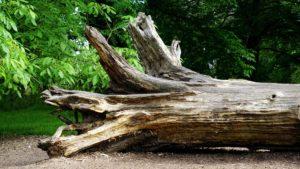At Brockley, we do our best to save trees. But on some properties, there may be a tree that is not wise to keep. In cases like this, using salt can be the simplest and most effective way of taking care of the plant.
It can be a preventative measure, too – the more you know about salt, the better you can prepare your trees when road crews spray this chemical over every road in Ontario.
How Does Salt Kill Trees?
 You may have heard of “salting the earth,” an old war tactic designed to make growing crops impossible. While the ancient soldiers may not have understood how it worked, they knew it was effective. Now, when property owners want to kill an isolated plant without affecting the surrounding plants, they can turn to salt.
You may have heard of “salting the earth,” an old war tactic designed to make growing crops impossible. While the ancient soldiers may not have understood how it worked, they knew it was effective. Now, when property owners want to kill an isolated plant without affecting the surrounding plants, they can turn to salt.
Salt disrupts how a plant can use nutrients to grow and thrive. The sodium ions prevent the flow of potassium and magnesium through the tree’s root system. These nutrients are necessary ingredients in the making of chlorophyll, and when a tree can’t make the chlorophyll it needs for food, it will die.
How Much Salt Will Kill A Tree?
 It can take a lot of salt to kill a tree. The salt has to interrupt the process at the roots, so it has to flow through the soil. It’s why trees near Canadian roads are more susceptible to death by salt, but the circumstances still need to be right.
It can take a lot of salt to kill a tree. The salt has to interrupt the process at the roots, so it has to flow through the soil. It’s why trees near Canadian roads are more susceptible to death by salt, but the circumstances still need to be right.
If you need to kill a tree – and there are many good reasons – salt can be the best solution, especially if you’re not comfortable with herbicides. Mix a solution with a very high amount of salt – two cups of water with one cup of salt should do it. Drill holes around the roots and pour your solution into the holes. Re-apply this solution every few days – the job should be complete after a few pours for small trees, but it can take a couple of weeks to affect larger trees.
When Would You Want To Kill A Tree With Salt?
Of course, you probably want to protect your trees from salt, which can be a challenge in winter. Deicing agents sprayed on the road are easily kicked up by vehicles and wind, turning trees nearby brown and appear burnt where the spray hits the leaves or needles. Don’t think that the distance from the road will always protect trees – road salt can affect trees 650 feet away if the route is well-trafficked.
If you think your trees are close to any splash, cover the lower trunks with burlap or surround them with snow fencing. By protecting the area around the tree, you can stop the sodium chloride from flowing through the soil after the snow melts.

